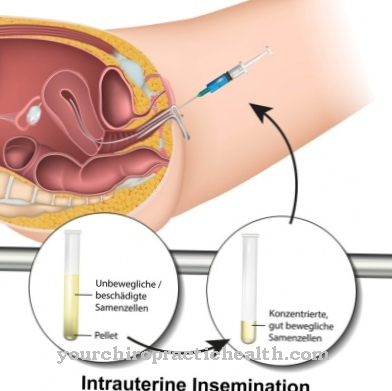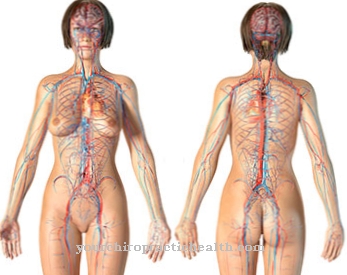The Retinal disease in high blood pressure (hypertensive retinopathy) occurs when high blood pressure (hypertension), which basically affects all organs of the human body, leads to changes in the retina.
What is retinal disease in hypertension?

© sveta - stock.adobe.com
An advanced stage of chronic retinal changes is called hypertensive retinopathy (retinal disease in high blood pressure) that can lead to permanent damage to the retina.
The retina in the back of the eye has special sensory cells (photoreceptors) that transmit color and light impulses to the brain via nerve cells. The retina, which is crucial for vision, is supplied by thin arterial blood vessels that can be damaged by high blood pressure, so that the supply of the retina is no longer adequately guaranteed.
The extent of the retinal damage depends on the duration and severity of the high blood pressure as well as on whether the hypertension is due to other diseases and at what age the high blood pressure appears. A retinal disease with high blood pressure can develop if the normal blood pressure values of 140/90 mmHg are exceeded again and again or permanently.
causes
A Retinal disease in high blood pressure can occur in an acute or in a chronic form. The possibility of acute retinopathy arises from a sudden increase in blood pressure in the presence of hypertension (“essential” or “primary” hypertension).
The "secondary" form of retinopathy, which can be found in fewer numbers but is more difficult to control, is due to another disease. These include diseases of the kidney (renal hypertension) or kidney vessels that may be narrowed or blocked. Even if the tumor type pheochromocytoma develops or later in pregnancy, hypertension can lead to retinopathies.
In the case of eclampsia, which mainly occurs in the last trimester of pregnancy, the preliminary stage of which is known as preeclampsia, it may occur. a. convulsions preceded by a rapid rise in blood pressure, headache and blurred vision. The pregnant woman concerned can then develop retinal disease due to high blood pressure ("eclamptic retinopathy").
Symptoms, ailments & signs
All forms of high blood pressure can lead to serious damage to the retina of both eyes in the long term. These changes usually occur gradually in chronic hypertension. In the event of an acute hypertensive crisis with very high blood pressure values, the retina can also be irreversibly damaged very suddenly.
Sudden visual disturbances in the context of a hypertensive crisis can indicate acute damage to the retina; it is an internal emergency that requires immediate treatment, also with the assistance of an ophthalmologist. Other complaints, symptoms and signs of retinal damage caused by high blood pressure can include dizziness, nausea and severe headaches.
The severity of the visual disturbances depends directly on the extent of the retinal damage. If the retinal damage is very pronounced and the cause, i.e. the far too high blood pressure, is not adequately treated, ultimately there is a risk of blindness. In patients with chronic high blood pressure, the retinal damage can also be asymptomatic, which means that good eyesight can also be present over a longer period of time.
However, if the hypertensive retinopathy continues to progress untreated, visual disturbances and increasing visual impairment in both eyes are inevitably the consequences. Serious complications with retinal damage due to hypertension have become less common due to the steady advancement of diagnostic and therapeutic options.
Diagnosis & course
An ophthalmologist can assist with a fundoscopy or ophthalmoscopy Retinal disease in high blood pressure Detect diseases of the retina in the back of the eye (fundus) with a light source and a magnifying glass after the pupils have been dilated by instillation of drops on the eyes.
After the patient has placed his chin on a support device, the eyes are illuminated one after the other with a thin beam of light. Under a microscope and magnifying glass, details of the retina (such as the blood vessels, the exit point of the optic nerve, the central point of sharpest vision and the choroid) can be viewed in three dimensions. After the pupils have dilated, the edges of the retina can be viewed. After the examination, the driver is unable to drive for six hours.
The retinal disease in high blood pressure is divided into four stages: In grade 1, slight narrowing of arterial vessels is diagnosed. In grade 2, either clear constrictions or different constrictions and widenings (so-called caliber fluctuations) of vessels can be observed.
In grade 3, edema (accumulation of fluid), downy cell areas whose function is restricted due to nerve fiber infarctions, and streak-like retinal hemorrhages are also found. In disease grade 4, the optic nerve at its exit point is swollen in retinal disease with high blood pressure.
Complications
The retinal disease in high blood pressure can lead to poor eyesight and even blindness if left untreated. With acute blood pressure peaks, retinal damage develops much faster than with chronically high blood pressure. The eye damage suddenly occurs here with massive visual disturbances which, if left untreated, can quickly lead to blindness. Sudden visual disturbances are an indication of acute high blood pressure for the doctor. However, this condition represents a medical emergency and urgently needs emergency medical treatment.
In addition to sudden visual damage, dizziness, nausea, massive headaches, sensory disturbances, paralysis, chest pain or shortness of breath can occur. These symptoms indicate that other organs are also affected due to the sudden spikes in blood pressure. If treatment does not start immediately, there is also a risk of a stroke or heart attack. The cause can be a derailed primary high blood pressure.
Sometimes it is also a sudden onset of secondary high blood pressure, which can be attributed to kidney disease, among other things. High blood pressure crises can also result from pregnancy complications. So-called preeclampsia can develop in late pregnancy, which can lead to high blood pressure crises.
The retinal damage caused by chronic high blood pressure or also by acute high blood pressure crises can improve again when the blood pressure normalizes. However, chronic retinal damage often remains, which is sensitive to all forms of high blood pressure. Although complete blindness has become rare today due to the good standard of therapy, it cannot be completely ruled out.
When should you go to the doctor?
If people suffer from high blood pressure, this should always be examined and checked by a doctor at regular intervals. The general state of health must be documented in the check-ups so that an immediate response can be made in the event of impending irregularities.
If these high-risk patients experience abnormalities or sudden changes in vision, a further visit to the doctor is necessary. In these cases, there is a need for quick action, since without immediate and extensive medical care there is a risk of blindness of the person concerned. Dizziness, unsteady gait, nausea or vomiting are signs that should be followed up. Headache or anxiety can develop in parallel and should be discussed with a doctor. An increased risk of accidents or falls must be presented to a doctor.
If there are unusual disturbances in visual perception or impaired vision, a doctor must be consulted. Blurred vision or changes in color perception should be examined and treated. An inability to clearly visualize the movements or outlines of people and objects is cause for concern. If the eyesight deteriorates within a few minutes or hours, a doctor must be consulted as soon as possible. If the person concerned reports a black curtain in front of the field of vision or a feeling of a swarm of insects in front of the eye, a doctor should be consulted.
Treatment & Therapy
The Retinal disease in high blood pressure must be treated with a systematic lowering of blood pressure. Blood pressure can be reduced by administering antihypertensive drugs or by changing your lifestyle.
Adjusting lifestyle habits should be a priority. This includes reducing any existing obesity and stopping cigarette consumption. A reduction in fat, salt and meat poorer food components in favor of fish, fruit and vegetables should be undertaken. Alcohol consumption is to be limited. Exercise should take place at least about three times a week for 30 minutes.
However, medication is often necessary, as hypertensive retinopathy indicates that the high blood pressure has been acting on the retina for a long time. As antihypertensive drugs, u. a. Diuretics (water preparations) and beta blockers are used. In the case of particularly severe hypertension, treatment is carried out in a clinic and, in an emergency, intensive care. If another disease is causing the high blood pressure, this disease must be treated.
If a high blood pressure patient had hypertension before pregnancy, a switch to suitable medication takes place. Particularly close care by the gynecologist is provided if there are signs of preeclampsia (e.g. moderate increases in blood pressure). In the case of retinal disease caused by high blood pressure in the form of eclampsia, only a premature delivery can possibly avert dangerous complications for both mother and child.
Outlook & forecast
The further course of the disease depends on the extent of the disorders suffered. In the case of long-term high blood pressure, the prognosis is significantly worse. There has been irreparable damage to the retina that cannot be regenerated. The person concerned is dependent on medical care for the rest of his life so that an alleviation of the symptoms can be documented.
In some cases, surgical interventions are necessary to improve vision. An unfavorable course of the disease leads to blindness and thus to severe restrictions in coping with everyday life. Due to the associated emotional stress, blindness can lead to secondary disorders and mental illness.If the disease progresses well, visual aids can be used that lead to improved visual perception.
Decisive for the further course of the disease and the prospect of an improvement in the overall situation is the willingness to change on the part of the person concerned. The lifestyle must be optimized so that the symptoms do not increase. In particular, the diet should be improved and the consumption of harmful substances should be completely avoided. Otherwise, despite all efforts, there will be a continuous deterioration in health. It should be noted that persistent high blood pressure puts stress on the circulatory system. A medical emergency can therefore develop at any time.
prevention
One Retinal disease caused by high blood pressure should be prevented by early detection measures. Patients with diabetes mellitus, kidney disease, and high blood pressure should have their heart, kidney, blood pressure and eyes checked at regular intervals. An annual eye examination is recommended from the age of 40.
Carrying out a cardiovascular check is part of the health insurance benefits catalog from the age of 35. Women who suffered from preeclampsia in the last trimester of pregnancy should have their heart and circulation checked regularly from the age of 40 because of the proven increased risk of hypertension in order to prevent retinal disease caused by high blood pressure.
Aftercare
Chronic retinal diseases caused by high blood pressure often require years of and sometimes even lifelong follow-up care. In mild cases, the retinal changes recede. However, the retina can also be irreversibly damaged. Then, lengthy follow-up examinations are often necessary to prevent even greater eye damage.
A chronically pathologically altered retina is particularly sensitive to fluctuations in blood pressure. It is therefore necessary to strive for a permanent reduction in blood pressure. However, it is often not so easy to stabilize blood pressure values despite intensive treatment, as hypertension can have different causes.
Sometimes it even takes several years for the doctor to find a suitable combination of drugs to lower blood pressure. At the same time, however, the patient should also seek permanent ophthalmological treatment in order to counteract the risk of worsening eye problems or blindness. The retinal changes should be constantly monitored by the ophthalmologist in order to be able to initiate suitable measures in the event of a significant deterioration.
Eye surgery may be required to prevent blindness. In addition, the follow-up examinations also serve to find an individual visual aid for the patient. The visual aid may have to be adjusted as the disease progresses. In very severe cases that lead to significant impairment of vision or even blindness, the patient may need long-term psychological support.
You can do that yourself
In the treatment of hypertensive retinopathy, the cooperation of the patient is of great importance, since antihypertensive agents alone often do not lead to sufficient improvement. In addition to regularly taking the medically prescribed medication, the patient usually has to change his or her lifestyle. Weight reduction is urgently recommended at the latest with a BMI of 25 or higher.
In addition, the diet should generally be changed. Fatty meat and sausage products should be avoided completely. Other animal fats, especially butter and cream, are also not recommended. Instead, those affected should consume plenty of fresh fruits and vegetables. Whole grains (pasta, rice, bread) and fermented soy products (tofu and tempeh) as well as pulses and sprouts are particularly suitable as a basis for the supply of energy and proteins. It is widely believed that salt intake should be reduced, although not all patients have a correlation between salt intake and blood pressure values.
In addition to nutrition, sufficient physical exercise is particularly important, with endurance sports having a particularly beneficial effect on blood pressure. We recommend five training sessions per week, each at least thirty minutes a day. Brisk walks, power walking, cycling, water aerobics and swimming are particularly suitable. Competitive sports and great physical exertion are better avoided. Alcohol should only be consumed in small quantities. Not using nicotine is also helpful.



.jpg)
.jpg)



















.jpg)



